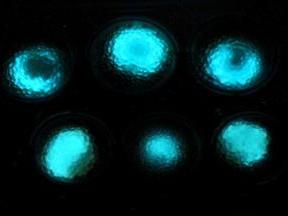Sweat-powered electronic skin
Electronic skin fully powered by sweat can monitor health
One of the ways we experience the world around us is through our skin. From sensing temperature and pressure to pleasure or pain, the many nerve endings in our skin tell us a great deal.

Sweat-powered electronic skin
Caltech
Our skin can also tell the outside world a great deal about us as well. Moms press their hands against our foreheads to see if we have a fever. A date might see a blush rising on our cheeks during an intimate conversation. People at the gym might infer you are having a good workout from the beads of sweat on you.
But Caltech's Wei Gao, assistant professor in the Andrew and Peggy Cherng department of Medical Engineering wants to learn even more about you from your skin, and to that end, he has developed an electronic skin, or e-skin, that is applied directly on top of your real skin. The e-skin, made from soft, flexible rubber, can be embedded with sensors that monitor information like heart rate, body temperature, levels of blood sugar and metabolic byproducts that are indicators of health, and even the nerve signals that control our muscles. It does so without the need for a battery, as it runs solely on biofuel cells powered by one of the body's own waste products.
"One of the major challenges with these kinds of wearable devices is on the power side," says Gao. "Many people are using batteries, but that's not very sustainable. Some people have tried using solar cells or harvesting the power of human motion, but we wanted to know, 'Can we get sufficient energy from sweat to power the wearables?' and the answer is yes."
Gao explains that human sweat contains very high levels of the chemical lactate, a compound generated as a by-product of normal metabolic processes, especially by muscles during exercise. The fuel cells built into the e-skin absorb that lactate and combine it with oxygen from the atmosphere, generating water and pyruvate, another by-product of metabolism. As they operate, the biofuel cells generate enough electricity to power sensors and a Bluetooth device similar to the one that connects your phone to your car stereo, allowing the e-skin to transmit readings from its sensors wirelessly.
"While near-field communication is a common approach for many battery-free e-skin systems, it could be only used for power transfer and data readout over a very short distance," Gao says. "Bluetooth communication consumes higher power but is a more attractive approach with extended connectivity for practical medical and robotic applications."
Devising a power source that could run on sweat was not the only challenge in creating the e-skin, Gao says; it also needed to last a long time with high power intensity with minimal degradation. The biofuel cells are made from carbon nanotubes impregnated with a platinum/cobalt catalyst and composite mesh holding an enzyme that breaks down lactate. They can generate continuous, stable power output (as high as several milliwatts per square centimeter) over multiple days in human sweat.
Gao says the plan is to develop a variety of sensors that can be embedded in the e-skin so it can be used for multiple purposes.
"We want this system to be a platform," he says. "In addition to being a wearable biosensor, this can be a human-machine interface. The vital signs and molecular information collected using this platform could be used to design and optimize next-generation prosthetics. "


























































